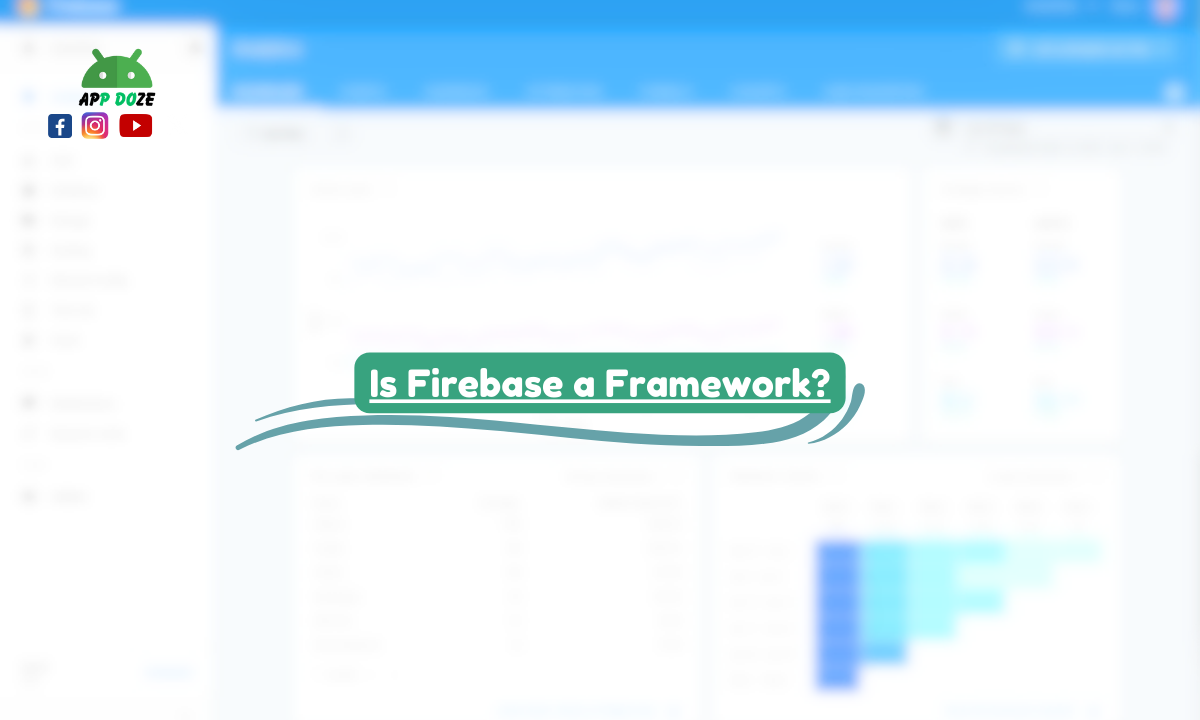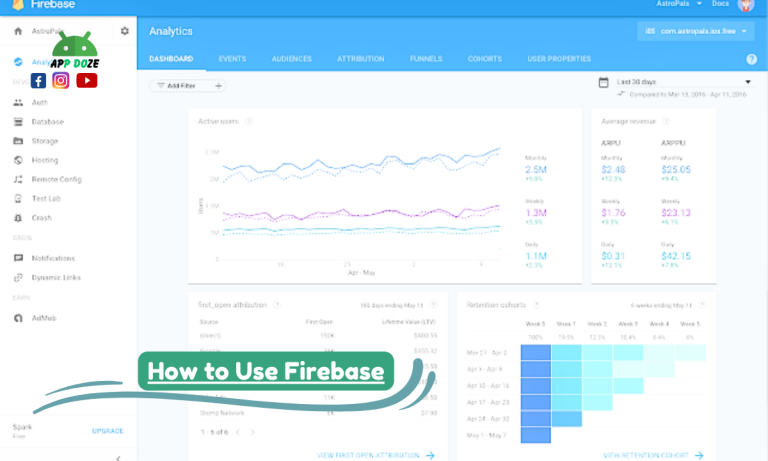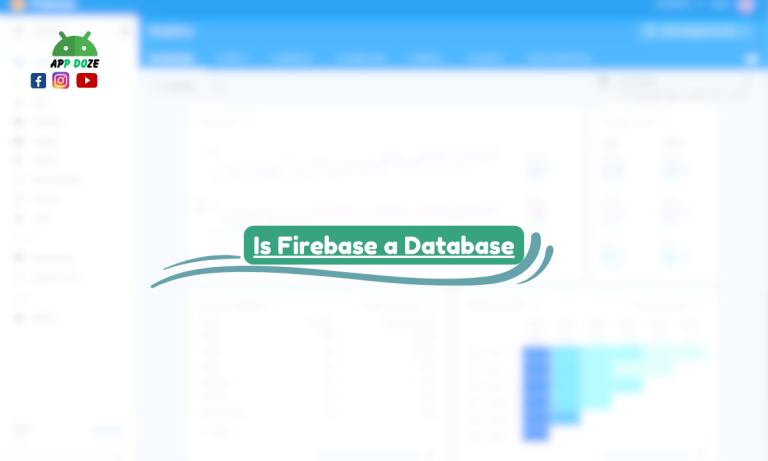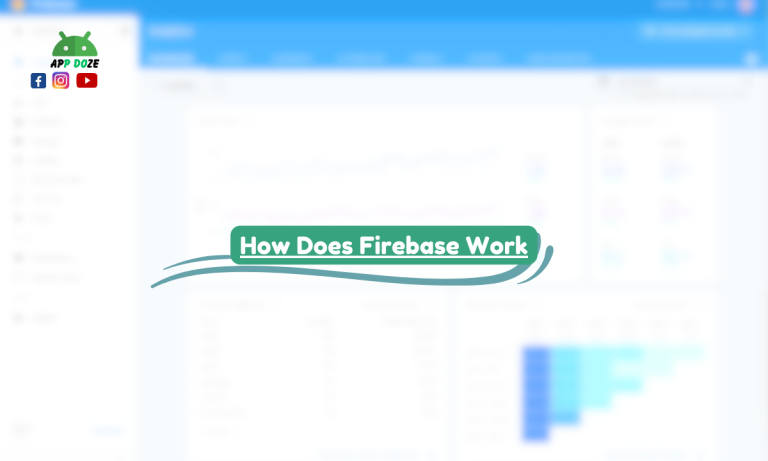If you’re diving into app development, you’ve probably heard of Firebase. It’s a tool many developers use to build apps without having to worry about managing complex server-side infrastructure. But there’s a lot of confusion about what Firebase is. Some people wonder if it’s a framework, others think it’s a library, and many see it as a backend service.

In this blog, we’ll clear up this confusion. Specifically, we’ll answer the question: Is Firebase a framework? Let’s break down what Firebase offers, how it works and help you understand its true role in app development.
What is Firebase?
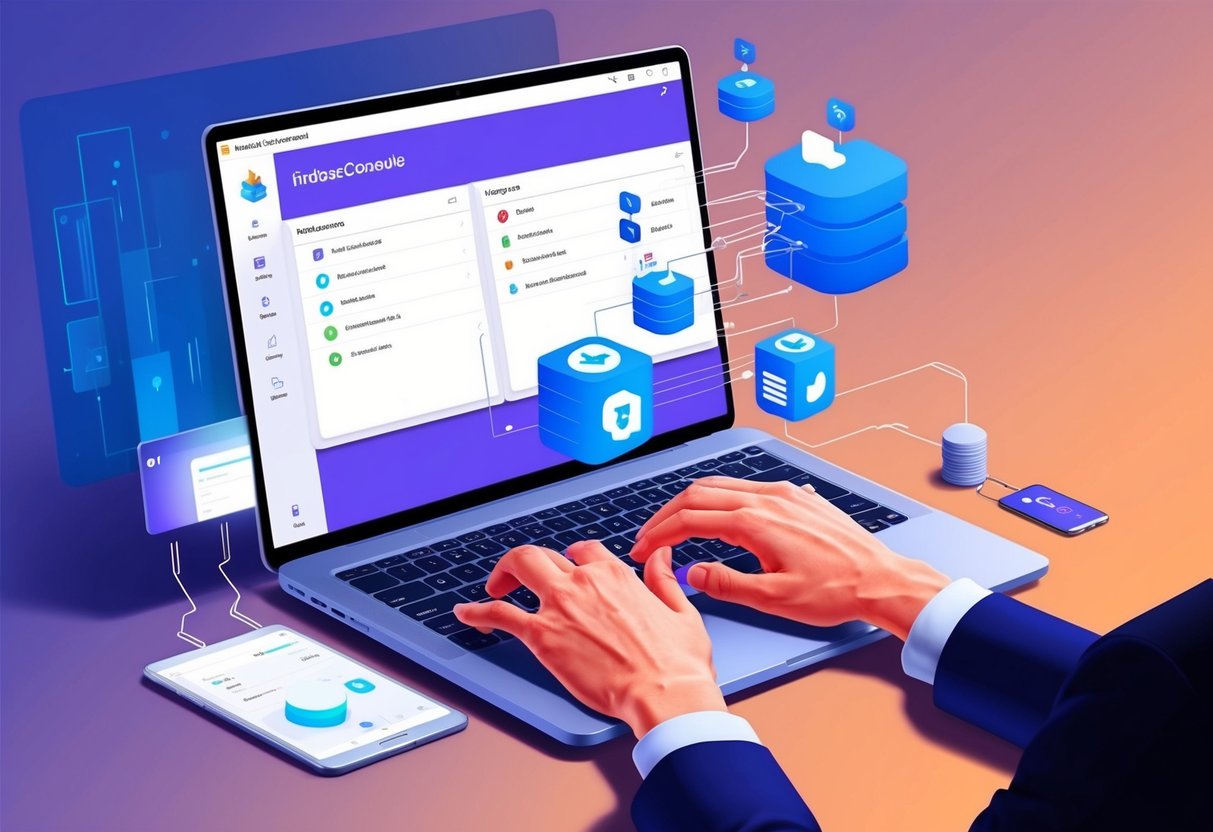
Firebase is a backend-as-a-service (BaaS) platform, which means it provides the server-side services you need to run an app without having to manage your servers. Essentially, it takes care of the heavy lifting behind the scenes so that you can focus on building the app itself.
Firebase offers a variety of features, including authentication, Firestore, Realtime Database, and much more. With Firebase, you don’t need to worry about setting up your backend infrastructure. Firebase takes care of things like user authentication, storing data, and handling server-side logic.
Here’s a quick look at some of its most important features:
- Authentication: Firebase provides an easy way to authenticate users, whether through email, Google, Facebook, or other login methods.
- Firestore: A flexible, scalable database for storing and syncing app data in real time.
- Realtime Database: A cloud-hosted database where data is stored as JSON and synchronized in real time across all clients.
One thing to understand is that Firebase brings together multiple services that can sometimes look like a framework or library. While it does provide tools that developers can use in their apps, it doesn’t force you into a specific structure, like a typical framework does. Instead, Firebase gives you the building blocks to create your app without imposing much on how you organize your code. This is why the line between frameworks and backends can get a little blurry. But at its core, Firebase is designed to make backend services as easy as possible to use.
Is Firebase a framework?
In software development, a framework is a set of tools and guidelines that help developers build applications. It provides a structure that makes it easier to create software by offering pre-written code and enforcing certain design patterns. Examples of popular frameworks are React, Angular, and Django. These frameworks guide you on how to structure your code and how the different parts of your app should work together.
However, Firebase is not typically classified as a framework. Unlike React, Angular, or Django, Firebase doesn’t impose a specific structure on how you build your app. Instead, Firebase provides the infrastructure you need to handle backend services, like authentication and data storage. This makes it easier to build the backend part of your app, but it doesn’t tell you how to organize your code or set up your front end.
In other words, Firebase helps you create the backend but doesn’t tell you how to set up the rest of your application. Firebase allows you to develop your app without forcing a specific structure, which is what makes it different from a traditional framework.
Is Firebase a backend?
In web and mobile development, the backend refers to the part of your app that runs on a server. It’s responsible for things like storing data, handling user authentication, and running business logic. The backend works behind the scenes to ensure your app functions correctly, while the frontend is what users see and interact with.
Firebase is primarily known as a backend-as-a-service (BaaS), which means it provides ready-to-use backend services. You don’t need to worry about setting up and managing your server because Firebase takes care of the server-side tasks for you. These services include things like data storage, user authentication, and the real-time database.
Firebase’s backend services are designed to make it easy for you to handle these tasks without needing deep knowledge of server management. For example, Firebase’s Firestore allows you to store and sync data in real time across all users, while Firebase Authentication handles logging users in and managing their accounts.
When comparing Firebase to traditional backends like Node.js or Express, the biggest difference is that Firebase is a managed service. In Node.js, for example, you’d need to build your backend infrastructure, set up your database, and handle things like security. With Firebase, all of that is taken care of for you. Firebase handles the backend infrastructure, so you don’t have to worry about the heavy lifting of server management.
Is Firebase a Good Backend?
When it comes to choosing a backend for your app, Firebase has a lot of benefits that make it a good choice for many developers. Here are some of the main pros of using Firebase as your backend:
- Ease of Use: Firebase is very beginner-friendly. You don’t need to be an expert to get started. It provides ready-to-use tools and clear documentation, which makes it easier for you to set up and manage your backend services.
- Scalability: Firebase scales automatically as your app grows. This means you don’t have to worry about upgrading servers or managing more infrastructure when your app gets more users. Firebase can handle it all for you.
- Real-Time Capabilities: Firebase offers powerful real-time features. For example, if you are building a chat app, Firebase’s Realtime Database can instantly sync changes across all devices without you needing to write complex code.
- Integration with Google Services: Since Firebase is owned by Google, it integrates smoothly with other Google services like Google Analytics and Google Cloud. This makes it easier to manage and analyze your app’s data.
However, while Firebase has many advantages, there are also some cons you should be aware of:
- Vendor Lock-In: Once you start using Firebase, it can be difficult to switch to another backend service. This is because your app is tightly connected to Firebase’s tools and infrastructure, making it challenging to migrate to a different platform.
- Query Limitations: Firebase uses NoSQL databases, which are great for certain types of data, but they don’t offer the same powerful querying capabilities as traditional SQL databases. If you need complex queries, Firebase might not be the best choice.
- Lack of Fine-Grained Control: Firebase abstracts a lot of the server-side management, which is great for simplicity, but it also means you have less control over the details. If you need to fine-tune your backend setup or implement custom features, you might find Firebase a bit limiting.
When compared to other backend technologies, like Node.js or Express, Firebase offers a lot of built-in services that save you time. While Node.js gives you full control over your backend, Firebase is easier to set up and manage. On the other hand, Firebase’s backend is more suited for apps that don’t require too much custom server-side logic. If your app is complex and needs a lot of customization, you might want to consider using traditional backend technologies.
Is Firebase a CMS (Content Management System)?
A Content Management System (CMS) is a platform used to create, manage, and store digital content. It’s designed to help users manage website content like articles, images, and videos without needing to know how to code. Some common CMS examples include WordPress, Drupal, and Joomla.
So, is Firebase a CMS? The short answer is no, Firebase is not a CMS. Firebase focuses on providing backend services like data storage, authentication, and real-time databases. It does not offer the same features that a traditional CMS provides, such as content creation, editing, or website management.
Firebase’s services are more geared toward handling the backend infrastructure for apps rather than managing content. While you can build an app or website using Firebase, it doesn’t include built-in tools to manage your content in the way a CMS does.
To explain further, with a CMS, you can easily create and organize articles, pages, and media files and publish them online. A CMS also often includes tools to control access and roles, like who can publish content and who can edit it. Firebase, on the other hand, is focused on providing the backend tools for your app, and it leaves the content management to you.
Firebase vs. Node.js: Key Differences
When choosing a backend for your application, you might find yourself debating between Firebase and Node.js. Both are popular options, but they have very different approaches to backend development. Here’s how they differ:
- Node.js is a runtime environment for executing JavaScript code on the server. It provides the tools needed to create and run backend services but does not include many built-in services. With Node.js, you need to configure things like the database, user authentication, and server setup manually. It’s highly flexible and gives you full control over how your backend operates, but it also requires more time and effort to set up.
- Firebase, on the other hand, is a backend-as-a-service (BaaS) platform. This means Firebase provides pre-configured tools and services like authentication, databases, hosting, and real-time communication that you can use right away. You don’t need to worry about configuring a server or managing infrastructure. Firebase abstracts much of the backend work, allowing you to focus more on building features for your app.
So, what are the trade-offs when deciding between Firebase and Node.js?
- If you choose Node.js, you get more control and flexibility. You can use any database, set up your hosting, and customize your backend exactly how you want it. However, this also means more manual configuration and more maintenance over time.
- If you choose Firebase, you’ll benefit from its ease of use. It handles most of the backend services for you, which saves you time. Firebase also offers great real-time features, making it easy to build interactive apps. But Firebase can sometimes be limiting in terms of customization, and you might face challenges if you need complex or specific configurations.
Firebase Explained: Overview of Core Features
Firebase offers a wide range of tools and services that can help you build powerful and scalable applications without much hassle. Let’s take a closer look at some of the core features Firebase provides:
- Firestore: Firestore is a flexible, scalable database provided by Firebase. It’s a NoSQL database that allows you to store and sync data in real time across all connected devices. This makes it perfect for apps that require live updates, like messaging or collaborative apps. Unlike traditional SQL databases, Firestore stores data in documents and collections, making it easy to organize and retrieve information.
- Firebase Authentication: This service lets you easily handle user authentication. You can allow users to sign up and log in with their email and password or through popular services like Google, Facebook, or Twitter. Firebase Authentication simplifies the process of managing user accounts, so you don’t have to build this functionality from scratch.
- Firebase Cloud Messaging (FCM): Firebase also helps you communicate with users through push notifications. With FCM, you can send notifications to users on both iOS and Android devices, as well as web apps. This makes it easy to keep your users engaged with real-time updates.
- Firebase Hosting: Firebase offers a secure and fast hosting platform for your web apps. You can deploy your website with just a few commands, and Firebase will handle the rest, from providing SSL certificates for security to ensuring fast content delivery.
- Firebase Analytics: Firebase provides built-in Google Analytics that help you track how users are interacting with your app. You can gain insights into user behavior, track events, and measure user engagement, which can help improve your app and make data-driven decisions.
How Firebase Simplifies App Development
Firebase is designed to make your life easier as a developer, especially if you’re new to backend services. Here’s how it simplifies app development:
- Pre-configured services: With Firebase, you don’t have to spend time setting up things like databases, authentication systems, or messaging services. These services are ready to use right out of the box, so you can focus more on building the features of your app.
- Real-time synchronization: Firebase’s real-time capabilities make it easy to sync data across all users instantly. For example, if you’re building a chat app, users will see new messages as soon as they are sent without needing to refresh the page or app.
- No server management: Firebase removes the need to manage your servers. All the infrastructure is handled for you, which means you don’t need to worry about scaling, security, or maintenance. Firebase takes care of all that, so you can focus on building and improving your app.
- Cross-platform support: Firebase works across Android, iOS, and web applications. This makes it easy to build apps that work on multiple platforms without needing to manage separate backends for each one.
Firebase Functions Tutorial
Firebase Functions are part of Firebase’s backend-as-a-service offering. They allow you to run server-side code in response to events triggered by Firebase features or HTTP requests. You can use Firebase Functions for a wide variety of tasks, like sending notifications, processing data, or running background tasks without managing your server.
What Are Firebase Functions and How Do They Work?
Firebase Functions are small pieces of code that run on Firebase’s cloud infrastructure. They are triggered by different events, such as changes in your Firebase database or HTTP requests. When the event occurs, the function executes automatically.
For example, if you want to send a welcome email to users when they sign up, you can create a Firebase Function that listens for new user registrations and sends an email whenever the event is triggered. This way, you don’t need to manually handle the logic or manage the server where the function runs.
Follow these simple steps to get started with Firebase Functions.
1. Set up Firebase in the Console:
- Go to the Firebase Console.
- Create a new project or select an existing one.
- Enable Firebase Functions by navigating to the Functions section from the left-hand menu.
2. Install Firebase Tools:
- On your computer, open a terminal and install Firebase CLI (Command Line Interface) by running this command:
nginx
CopyEdit
npm install -g firebase-tools - After installing it, log in to Firebase using this command:
nginx
CopyEdit
firebase login
3. Initialize Firebase Functions in Your Project:
- In your project folder, run:
bash
CopyEdit
firebase init functions - This will guide you through the process of setting up Firebase Functions in your project. You will be asked to choose a language (JavaScript or TypeScript) for your functions.
4. Write and Deploy a Simple Firebase Function:
- Inside the functions folder created during initialization, open the index.js (or index.ts if using TypeScript) file.
- Write a simple function that responds to HTTP requests:
JavaScript
CopyEdit
const functions = require(“firebase-functions”); exports.helloWorld = functions.https.onRequest((request, response) => { response.send(“Hello, Firebase!”); }); - To deploy the function, run:
bash
CopyEdit
firebase deploy –only functions - After deployment, your function will be available via the provided URL.
5. How to Trigger Firebase Functions:
Firebase Functions can be triggered in a few different ways:
- HTTP Triggers: Functions can be triggered by HTTP requests, like the one in the example above. These are useful for building APIs or webhooks.
- Firestore Triggers: Functions can also respond to changes in Firestore data. For example, you could trigger a function when a document is created, updated, or deleted in your Firestore database:
JavaScriptCopyEdit exports.newUser = functions.firestore .document('users/{userId}') .onCreate((snap, context) => { const newValue = snap.data(); // Process new user data return null; });- Realtime Database Triggers: Similar to Firestore, you can set up functions that trigger when data changes in the Firebase Realtime Database.
You can use other types of triggers as well, such as Firebase Authentication triggers or Firebase Analytics triggers, depending on your needs.
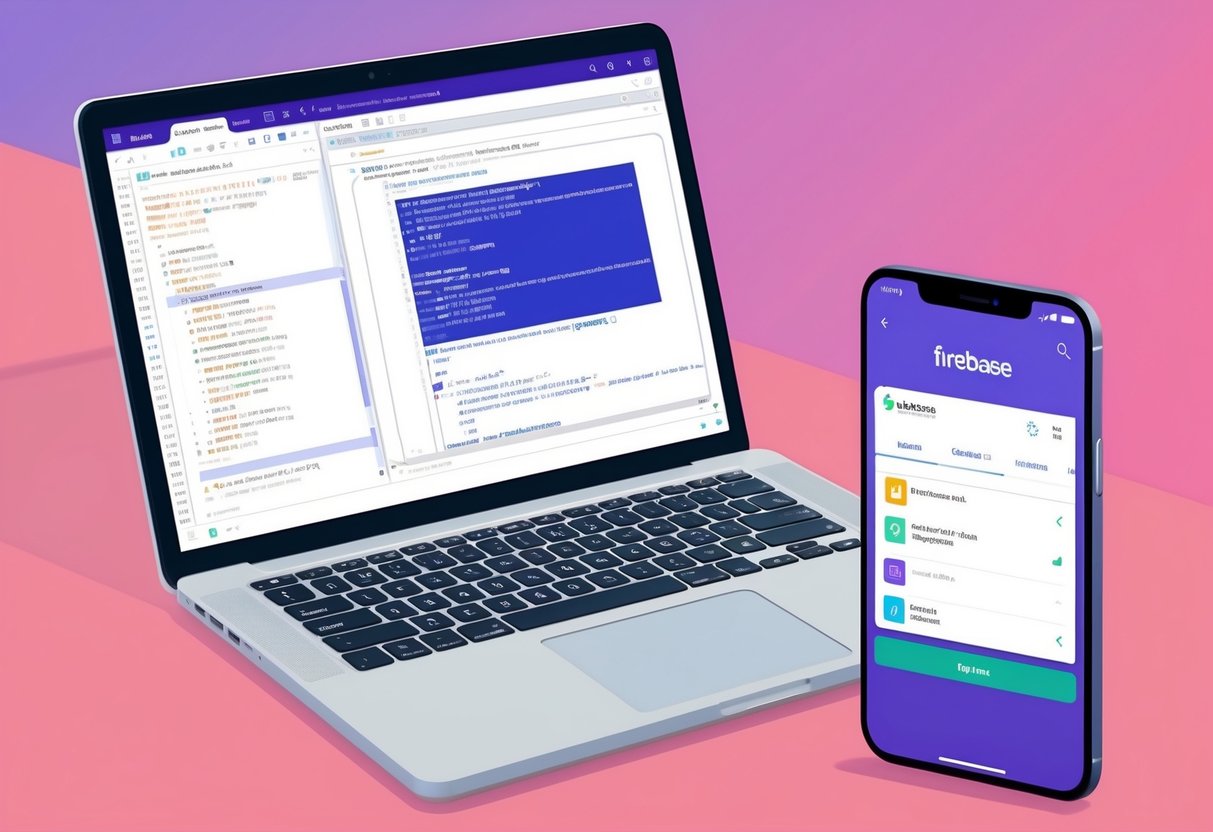
Is Google Firebase a framework?
When people hear the term Firebase, they might assume it’s a development framework. However, Google Firebase is a backend platform and not a traditional framework.
Google’s Role in Firebase
Google owns Firebase, and it provides a set of tools and services to help developers build mobile and web applications. Firebase integrates various Google services and makes it easier to set up the backend infrastructure for your apps. This includes things like real-time databases, cloud storage, authentication, and more.
Last Words
A framework typically provides a set of rules and structures for organizing and building applications. Frameworks like React, Angular, or Django enforce certain patterns and provide specific tools for structuring your app. They help guide your app’s architecture, forcing you to follow a certain development methodology.
In contrast, Firebase doesn’t work in the same way. Firebase is a backend-as-a-service (BaaS) that offers various tools and SDKs (software development kits) for handling backend tasks like database management, user authentication, and cloud functions. While Firebase offers a lot of useful services, it doesn’t enforce a particular structure for how you build your app. You’re free to design your app however you like, without having to follow a specific pattern or structure.
Firebase does provide SDKs and libraries that help developers interact with these services, which might look similar to libraries in a framework. But Firebase doesn’t provide the full development structure that frameworks like React or Angular offer. You can use Firebase alongside any framework or even without one, depending on your needs.
FAQs
Is Firebase a framework or library?
Firebase is neither a framework nor a library. It is a backend-as-a-service (BaaS) that provides a set of tools for building and managing backend services.
Can Firebase replace a backend server?
Yes, Firebase can replace a traditional backend server by providing database management, authentication, cloud functions, and more. However, it doesn’t offer full control over server infrastructure like a custom backend might.
What are Firebase Functions?
Firebase Functions allow you to run server-side code in response to events. These functions are triggered by changes in Firebase services like Firestore or by HTTP requests, helping automate backend tasks.
Is Firebase a CMS?
No, Firebase is not a Content Management System (CMS). While it offers storage and database services, a CMS is specifically designed to manage digital content and organize it in a way that’s easy for non-technical users to handle. Firebase does not provide the same features.
How does Firebase compare to traditional backends like Node? js
Firebase abstracts much of the backend management, handling things like database, authentication, and hosting. Traditional backends like Node.js, on the other hand, require more manual setup and configuration but offer more flexibility and control. Choosing between the two depends on your project’s needs.

Charles Mata is an experienced app developer and educator, passionate about helping others build powerful mobile applications. He publishes in-depth guides on app development, covering Android Studio, Firebase, Google Play Console, and more. With a practical approach, he simplifies complex coding concepts, making them easy for beginners and advanced developers alike.
Charles also offers a premium website development course, where he teaches step-by-step strategies to build, optimize, and scale websites for success. Whether you’re a beginner looking to learn app development or an entrepreneur wanting to create a website, his expert insights will guide you every step of the way.

